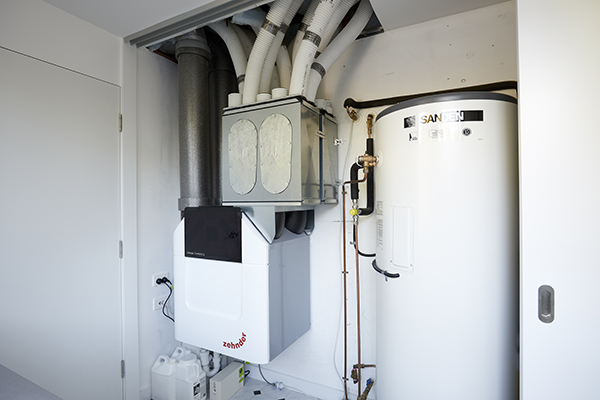How Long Does HRV Remain Effective? Breaking Down System Lifespan
Exactly How Heat Recovery Ventilation Enhances Indoor Air High Quality and Reduces Energy Prices
Heat Recovery Ventilation (HRV) systems play a necessary role in boosting indoor air top quality while simultaneously decreasing energy costs. By efficiently trading stale interior air with fresh outdoor air, HRVs assist maintain suitable humidity and minimize pollutants. In addition, their capability to recoup warm from outbound air reduces the strain on home heating and cooling down systems. As energy prices continue to climb, understanding the complete possibility of HRV systems ends up being significantly vital for property owners and services alike.
Understanding Heat Recovery Ventilation Solutions

Heat recovery ventilation (HRV) systems play an essential function in improving interior air quality, specifically in modern, energy-efficient structures. These systems are created to transfer warm from the outward bound stagnant air to the inbound fresh air, thus lessening power loss while maintaining excellent temperature degrees inside. HRVs contain a warmth exchanger, fans, and ductwork, helping with the continuous blood circulation of air. By eliminating interior pollutants and presenting fresh air, HRVs help to balance moisture degrees, avoid mold and mildew growth, and minimize allergens. The efficiency of HRV systems depends on their capacity to recuperate approximately 80% of the warmth from the worn down air, advertising power preservation while making sure a healthy and balanced interior setting. Their assimilation is crucial in accomplishing sustainable living methods.
The Significance of Indoor Air Quality
Indoor air quality (IAQ) is a crucial factor influencing the health and wellness and well-being of passengers in any kind of atmosphere. Poor IAQ can bring about different health and wellness issues, including breathing problems, allergic reactions, and exhaustion. Furthermore, it can intensify existing problems such as asthma. Variables contributing to low IAQ consist of contaminants from indoor sources like cleansing agents, mold, and inadequate air flow. Consequently, keeping good IAQ is vital for advertising a risk-free and comfy living or working room. Efficient techniques to improve IAQ include routine tracking of air top quality, correct ventilation systems, article and reducing making use of unsafe compounds indoors. By focusing on IAQ, individuals can assure a healthier setting that cultivates performance and total lifestyle.
Power Performance Benefits of HRV Systems
Lots of home owners and structure managers are increasingly acknowledging the power effectiveness advantages of warm recuperation air flow (HRV) systems. By moving warm from worn down interior air to incoming fresh air, HRV systems considerably decrease the power needed for home heating and air conditioning. This procedure minimizes reliance on traditional cooling and heating systems, bring about reduced energy costs. Additionally, HRVs aid preserve a well balanced interior environment, avoiding too much home heating or cooling demands. The capability to recoup as much as 90% of the heat from outbound air additionally sustains sustainability efforts by minimizing total power intake. HRV systems add not only to set you back financial savings yet additionally to a lowered carbon footprint, aligning with the expanding focus on energy-efficient structure practices.
Installation and Upkeep Considerations
The efficient application of warm recuperation ventilation (HRV) systems needs mindful consideration of installment and upkeep factors to assure peak performance. Appropriate positioning of the HRV system is necessary, as it needs to be mounted in an area that takes full advantage of airflow while decreasing noise disturbance. In addition, ductwork has to be suitably sized and protected to stop energy loss. Regular upkeep, consisting of filter substitute and system cleansing, is important to protect optimal performance and indoor air high quality. Owners need to develop a normal maintenance schedule to determine and address possible problems prior to they escalate. Cooperation with experienced experts throughout both setup and upkeep stages can enhance the durability and performance of HRV systems, eventually resulting in better indoor atmospheres and reduced power costs.
Real-World Applications and Success Stories
Exploring real-world applications of warmth recovery air flow (HRV) this link systems discloses their significant effect on indoor air top quality and power effectiveness across different setups. In domestic structures, homeowners have actually reported improved air top quality, leading to less allergic reactions and respiratory system concerns. Schools implementing HRV systems have actually kept in mind boosted pupil focus and reduced absenteeism because of far better ventilation. Commercial buildings, such as workplaces and retail rooms, have experienced lower energy prices and boosted staff member productivity. A company workplace in a temperate climate achieved a 30% reduction in power bills after mounting an HRV system. These success tales demonstrate that HRV technology not just adds to healthier atmospheres but additionally offers tangible economic advantages, making it a useful investment for numerous markets.
Frequently Asked Concerns
Can HRV Solutions Reduce Allergens in Indoor Air?
The effectiveness of HRV systems in minimizing indoor irritants mostly rests on their capability to filter and exchange air. HRV Heat Recovery Ventilation. By constantly replacing stagnant air, these systems can significantly lower allergen degrees throughout interior environments

How Does Humidity Affect HRV System Performance?
Humidity substantially influences HRV system performance; high levels can bring about condensation, lowering efficiency, while reduced moisture may boost air exchange. Balancing moisture is crucial for ideal procedure and preserving indoor air high quality.
Are HRV Solutions Noisy Throughout Operation?
HRV systems can produce differing noise degrees throughout operation, depending upon their layout and setup. Some units operate silently, while others may produce noticeable noise, especially at greater air movement settings or when poorly kept.
What Is the Ordinary Life Expectancy of an HRV System?

Can HRV Systems Be Used in All Environments?
HRV systems can be used in various climates, however their effectiveness might vary - HRV Heat Recovery Ventilation. In extreme temperatures, modifications or supplementary systems may be necessary to assure perfect efficiency and comfort while preserving indoor air high quality